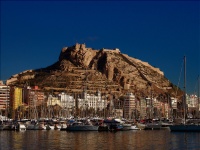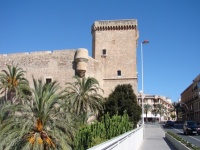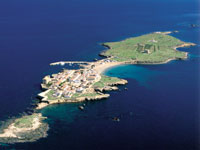Costa Blanca Travel Guide
The Costa Blanca lies on the eastern coast of Spain and draws millions of tourists each year to its turquoise waters and miles of white, sandy beaches. Though Alicante is the capital and major city on this stretch of coast, Benidorm attracts the most visitors, and it's the place to go for lively bars and all-night clubs. However, there's more to the Costa Blanca than crowded beach resorts, as the mountainous interior has a series of fascinating medieval towns and fortified villages that have been largely unaffected by modern development.
Alicante is best known as the gateway to the many glittering resorts in the region, but the city is actually an interesting urban destination, with history and culture aplenty to offer those who can be drawn from the beach. Travellers who have some time should head to the Catedral de san Nicolas from which the narrow old streets of the historic quarter, El Barrio, spread.
The most popular time to visit the Costa Blanca is between May and October when the weather is guaranteed to be sunny and warm most of the time. The temperature can get up to 104ºF (40ºC) in August, with the sea at a very comfortable 77ºF (25ºC). It's too hot and crowded for some during this busy summer season and the spring and autumn months also appeal to travellers, as it's cooler and there's the chance of light showers. Visitors should note that many of the bars and restaurants close outside of the peak tourist season.
Things to do in Costa Blanca
The myriad attractions of the Costa Blanca's beach resorts include gorgeous white-sand shores, turquoise Mediterranean waters and a rollicking nightlife. Those intent on doing some actual sightseeing in the region should explore the more authentic villages just inland, some of which host weekly craft markets.
Of the famous resorts the charming Altea is the least commercial and the best place to get a taste of real local culture. Altea has a renowned craft market every Tuesday, between April and September, and La Nuncia, just north of Altea, has a good Sunday market. Culture seekers should also take advantage of Alicante's historical attractions.
The formidable Moorish Castell de Santa Barbara looms over Alicante and visitors can explore some of the tunnels, dungeons, towers and chambers that make up the impressive fortress. The tiny, picturesque Isla Tabarca is a popular excursion from Alicante, and the city of Elche, inland from Alicante, is worth seeing too, as it has Europe's only palm forest.
For amusement park thrills and spills, instead of culture, visitors should head to Spain's largest theme park, Terra Mitica, just outside of Benidorm.

Castell de Santa Barbara
The impressive Santa Barbara Castle has its origins in the Muslim rule of the 9th century, and towers over Alicante on top of the Benacantil Mountain. Most of the chambers that can be explored today date from the 16th, 17th and 18th centuries. The fortress is massive, encompassing moats, drawbridges, tunnels, cisterns, and dungeons, not to mention a stately tower and keep. It has endured many attacks, rebuilds, and renovations during its long history and was opened to the public in 1963. Today it houses the Museum of the City of Alicante. From the top of the castle superb views over the bay and the city can be enjoyed.

Museo de Arte Contemporaneo de Alicante
Alicante's oldest building stands in the Plaza de Santa Maria, and it began as a granary in 1685. Today, and somewhat ironically, the city's oldest building contains its most notable modern art collection, which was donated by painter and sculptor Eusebio Sempere in 1977. The Museo de Arte Contemporaneo de Alicante is commonly referred to simply as MACA. Among the noteworthy paintings on display are those by Dali, Picasso, Calder, and Miro, and one of the highlights is the section dedicated to Sempere's own geometrical, moving sculptures. As other famous modern art galleries have realised, the contrast between an old building and a colourful modern art collection is striking.

Elche
Europe's only palm forest is just 12 miles (19km) inland and to the west of Alicante, and it forms a lush oasis around the city of Elche. The city boasts several beautiful parks, public gardens and palm groves, and the Palmeral of Elche, an orchard of more than 200,000 palm trees, is a UNESCO World Heritage Site. The Parque Municipal is one of the most popular places to enjoy the trees, with the palms interspersed by grassy promenades and children's playgrounds. The most beautiful palm garden is the Huerto del Cura, which is filled with trees, water features and bright flowerbeds. Another attraction in the city, located right next to the municipal park, is the Altamira Castle, which was built in about the 12th century and was renovated in the 15th century.

Isla Tabarca
The tiny islet of Tabarca is becoming an increasingly popular day trip destination from Alicante or Santa Pola, with its quiet fishing village offering an old fort, several very reasonably priced fresh seafood restaurants, a rocky beach with clear turquoise water, and several coves and tidal pools ideal for bathing. Tiny and picturesque, Tabarca is the smallest permanently inhabited islet in Spain and can very easily be explored on foot. The islet is part of a marine reserve (Reserva marina de la Isla de Tabarca) and promises varied marine life, clear unpolluted waters, and a healthy bird population.
Spain travel info
Electricity
The electrical current is 230 volts, 50Hz. European-style two-pin plugs are standard.
Language
Spanish is the official language, but English is widely understood in areas frequented by tourists. Catalan, Galician and Basque are spoken in the relevant areas.
Money
Spain's official currency is the euro (EUR), which is divided into 100 cents. Money can be exchanged at bureaux de change and major hotels, but banks give the best rates. All major credit cards are widely accepted at most hotels, restaurants, and shops. ATMs are widespread and are generally the cheapest and most convenient method of obtaining money.
Tipping
Hotel and restaurant bills usually include service charges, but additional tips are welcomed for services rendered. In established restaurants, tips of about 10 percent are expected. Drivers of metered taxis expect small tips and it's customary to tip about 5 to 10 percent for most services, including guides.
Health
There are no health risks associated with travel to Spain, and no vaccination certificates are required for entry. Medical facilities are good but comprehensive travel insurance is always advised. Spain has a reciprocal health agreement with most EU countries that provides emergency health care for EU travellers on the same terms as Spanish nationals. After Brexit, the Global Health Insurance Card (GHIC) replaced the European Health Insurance Card (EHIC) for UK citizens. The GHIC allows UK citizens access to state healthcare during visits to the EU. The GHIC is not valid in Norway, Iceland, Liechtenstein or Switzerland, nor is it an alternative to travel insurance. EU travellers should take a European Health Insurance Card (EHIC). Travellers should take any medication they require along with them, in its original packaging and accompanied by a signed and dated letter from a doctor detailing what it is and why it is needed.
Safety
Most visits to Spain are trouble-free except for occasional street crime. Petty crime, such as pickpocketing and purse snatching, is most common in larger cities, particularly during holidays, festivals and weekends, and especially on public transport and in tourist areas. Thieves may work alone or in groups; visitors should be wary of strangers who offer or ask for help of any kind, or inform them of a stain on their clothes, as these are often ways of providing a distraction for accomplices. There are also scams involving letters for outstanding traffic fines or Spanish lottery winnings. Travellers can avoid incidents if they exercise all the normal precautions.
Local customs
Smoking in public places is banned and stiff fines will be imposed for smoking in areas such as enclosed public spaces, areas where food is prepared and sold, public transport, non-smoking areas of bars and restaurants, and any places that cater for children. Drinking alcohol in the streets of Madrid and the streets of the Canary and Balearic Islands is illegal.
Doing business
The business culture in Spain is slowly shifting but, for now, it's entrenched in tradition and it can take some time for foreigners to gain a foothold in the Spanish working world. It's important never to undermine authority as hierarchy is central to Spain's business world. Managers tend to make decisions without considering input from their colleagues.
A strong emphasis is placed on social status, character attributes, and personal pride. Success is often hinged upon being well-dressed, honourable, and dignified, while also exhibiting great social skills. Business meetings are generally conducted face-to-face and can go on for long periods, as Spaniards prefer long deliberations in order to avoid uncertainty in corporate dealings. Business meetings in Spain tend to tread a fine line between personal and formal.
Conducting business in Spain can entail navigation through a lot of red tape and bureaucracy. Spanish is the language of business, but some of the larger multinationals conduct meetings in both English and Spanish. Business hours are often quite varied, but generally open by 9am and close in the mid-evening with a two-hour lunch break during the early afternoon.
Business attire is quite conservative with men wearing dark or linen suits, shirts and silk ties. Women should wear modest dresses or tailored suits. Brand names or labels attract affirmation from colleagues and associates.
After the conclusion of successful negotiations, gifts are appropriate. Gifts should be of high quality and, when receiving a gift, it should be opened in front of the giver. Business cards are important and should be bilingual. Meetings are best scheduled for mid-morning, and establishing a formal yet personable environment is important before beginning. Meetings often occur over lunches and dinners.
Duty free
Travellers from EU countries are allowed the following items duty free: 800 cigarettes or 400 cigarillos or 200 cigars or 1kg tobacco; 110 litres beer; 90 litres wine; and 10 litres spirit. Travellers from non-EU countries may have 200 cigarettes or 100 cigarillos or 50 cigars or 250g tobacco; 1 litre spirits, 4 litres wine, and 16 litres beer.
Communications
The international access code for Spain is +34. WiFi is widely available; travellers can purchase local SIM cards for unlocked phones or use eSIMs if their cellular providers support it on their networks.
Passport & Visa
The borderless region known as the Schengen area includes the following countries: Austria, Belgium, Czech Republic, Denmark, Estonia, Finland, France, Germany, Greece, Hungary, Iceland, Italy, Latvia, Lithuania, Luxembourg, Malta, The Netherlands, Norway, Poland, Portugal, Slovakia, Slovenia, Spain, and Sweden. All these countries issue a standard Schengen visa that has a multiple entry option, allowing the holder to travel freely within the borders of all. Non-EU nationals must hold a return or onward ticket, all necessary documents for onward travel and sufficient funds. It is highly recommended that passports have at least six months' validity remaining after the intended date of departure from Spain. Immigration officials often apply different rules to those stated by travel agents and official sources.
Entry requirements
United States citizens require a passport valid for three months beyond the period of intended stay. No visa is required for stays of up to 90 days within a 180 day period.
British citizens require a passport valid for three months beyond the period of intended stay. No visa is required for stays of up to 90 days within a 180 day period.
Canadian citizens require a passport valid for at least three months beyond period of intended stay. No visa is required for stays of up to 90 days within a 180 day period.
Australian citizens require a passport valid for at least three months beyond period of intended stay. No visa is required for stays of up to 90 days within a 180 day period.
South African citizens require a passport valid for at least three months beyond period of intended stay. A visa is required.
Irish nationals require a valid passport, but a visa is not necessary.
New Zealand citizens require a passport valid for at least three months beyond period of intended stay. No visa is required for stays of up to 90 days within a 180 day period.
Useful contacts
Spanish Tourist Office, Madrid: www.spain.info.
112 (General).Embassies / consulates in other countries
Spanish Embassy, Washington, United States: +1 202 452 0100.
Spanish Embassy, London, United Kingdom: +44 0207 235 5555.
Spanish Embassy, Ottawa, Canada: +1 613 747 2252.
Spanish Embassy, Canberra, Australia: +61 02 6273 3555.
Spanish Embassy, Pretoria, South Africa: +27 012 460 0123 (ext. 116/117).
Spanish Embassy, Dublin, Ireland: +353 01 283 9900.
Spanish Consulate, Wellington, New Zealand: +64 04 802 5665.
Embassies / consulates in Spain
United States Embassy, Madrid: +34 91 587 2200.
British Embassy, Madrid: +34 91 714 6300.
Canadian Embassy, Madrid: +34 91 382 8400.
Australian Embassy, Madrid: +34 91 353 6600.
South African Embassy, Madrid: +34 91 436 3780.
Irish Embassy, Madrid: +34 91 436 4093.
New Zealand Embassy, Madrid: +34 915 230 226.



